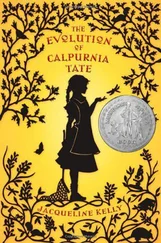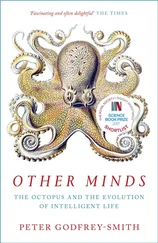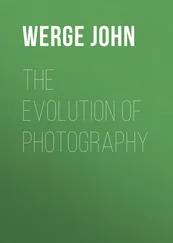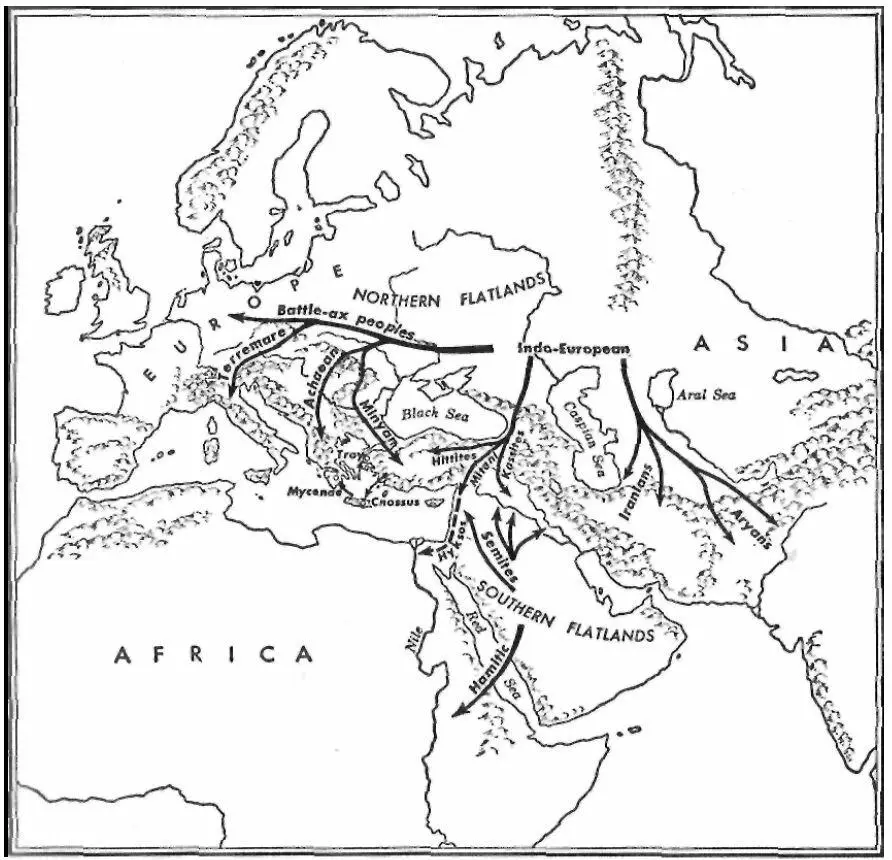
Bronze Age invasions from the Flatlands (3000-1000 B.C.)
My own opinion on the mesolithic is that it was a period of progress to a higher culture, in terms of technology and human productivity, and that it was not a local invention but rather came in from the tropical forest zone where a somewhat similar way of life must have existed for a considerable period. There is no space here for the rather technical arguments that would support this theory of mesolithic diffusion from a tropical forest area, but it is possible to mention the kind of evidence that would be used.
In Pin Hole Cave in England, just at the level where the mesolithic evidence begins, was found an Indian Ocean cowrie shell. Obviously, if a shell could come that distance, some of the new techniques of mesolithic culture could come the same route. Or again, Europe's first domestic animal, the dog, whose origins seem to go back to southeast Asia, arrived just at the beginning of the mesolithic period. This animal, well adapted to small-game forest hunting and to the sedentary, trash-accumulating life of the mesolithic, could have come by the same route as the cowrie shell. Moreover, in the very late mesolithic period in Europe there appeared two other domestic animals, the fowl and swine. Both of these are of Asiatic tropical forest origin and thus have quite a distinct source from the later Highland Zone domestic animals associated with early peasant agriculture. These later animals, such as sheep, goats, and cattle, are grass-eating Highland Zone herd animals, and are not tropical forest gleaners as are the chicken and pig.
Mesolithic technology had a much reduced concern with stone tools and a greatly increased concern with fiber cords and wickerwork. It included fish lines and fishhooks, nets and weirs, snares, bows and arrows, permanent huts of wicker and mud (or, as the English say, "wattle-and-daub"), basketry, canoes and paddles and, toward the end of the period (4000 B.C.), crude pottery and even some crop planting. The evidence for this new mesolithic technology, which has recently been described by J. G. D. Clark of Cambridge University, is often to be found in shell heaps and trash mounds ("kitchen midden") associated with the mesolithic's sedentary settlements.
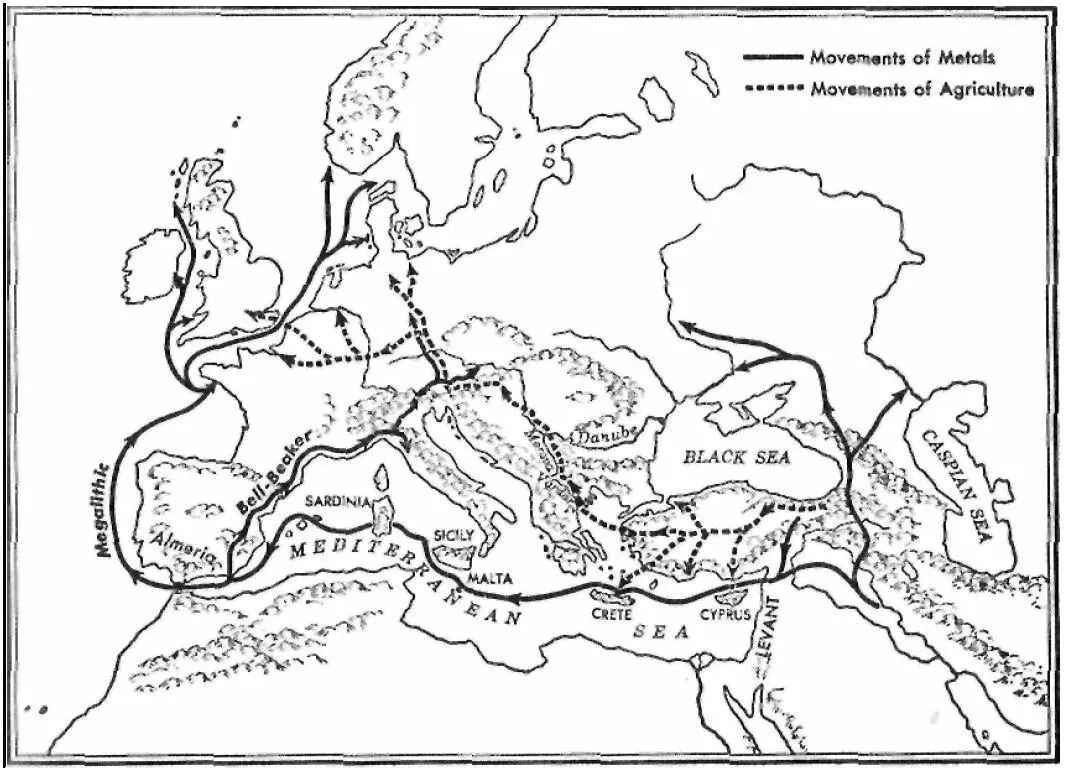
Movements of metals (solid line) and of agriculture (broken line) to Europe 4000-2000 B.C.
At the end of the third millennium B.C., this mesolithic way of life was disrupted by a series of events that pushed European societies forward to new economic levels. About 2700 B.C., a cultural movement from the Levant or southern Anatolia had arrived in southeastern Spain by way of the Mediterranean. This movement, sometimes called the megalithic movement, brought to Europe a number of cultural innovations, of which the chief was the use of metal (copper and bronze). From southwestern Spain, near Al-meria, these innovations spread to Europe by two subsidiary routes. While the megalithic movement went on to western Europe by sea, crossing the Atlantic waters and the Bay of Biscay to Britanny (2500 B.C.) and the narrow seas to Britain and Denmark (2200 B.C.), groups of Spanish origin, called the Bell-Beaker people, moved northward, across the Pyrenees and southern France, to northern Italy, Switzerland, and central Europe by land.
At the very time that the megalithic and Bell-Beaker movements were bringing metals to Europe from the west, the Neolithic Garden cultures were bringing Highland Zone peasant agriculture to Europe from the east. This innovation first appeared, according to the available evidence, in the Western Asiatic Highland Zone, possibly near Armenia, in the seventh millennium B.C. As we have already indicated, the search for fertile plots of semiopen parklands resulted in a steady diffusion of this culture and its peoples. Crossing Anatolia and the Aegean Sea, they were in northeastern Greece by 3500 and then proceeded, by way of the Vardar-Morava route, to the middle Danube. While some descended the river to Romania and Bessarabia, where further passage was blocked by the warlike hunters of the steppes, others moved upstream across the loess lands of Hungary to Austria, the shores of Swiss lakes, and the Upper Rhine. Down the Rhine they proceeded to the lower valley whence they fanned out, going eastward across southern Germany and westward across northern France. By 2200 the latter branch had crossed into England, and within a few generations the central European branch was moving into Denmark from the south.
In this way both agriculture and metals had penetrated to western and central Europe before the onset of Sub-Boreal climate brought in the Bronze Age horse-using Indo-European warrior peoples from the eastern steppes. The arrival of these new people and of drier Sub-Boreal climate led to a drastic reorganization of Europe's societies. The climate change, by 2000 B.C., opened the forests of Europe, so that megalithic traders abandoned the seaways of the west in all of southwestern Europe as far east as the Adriatic and as far north as Britanny and, instead, crossed Europe by boat on the rivers, bringing Irish gold, Cornish tin, and Danish amber across Bohemia and southern Germany to the Danube. Down this river they went to the mouth of the Morava where they split, some continuing down the Danube, while others turned south to the Isthmus of Corinth and the Gulf of Argos beyond. In Argos, the new commercial cities of Mycenae and Tiryns welcomed the northern traders and grew rich from their commerce, which continued on, by sea, to Crete, to Egypt, or to the Syrian Saddle. Those traders who had continued down the Danube crossed Thrace to receive an equally warm welcome in Troy, whence the trade routes continued across Hittite Anatolia and the Assyrian outposts in Cilicia to the Syrian Saddle and Mesopotamia. These European trade routes of the Sub-Boreal period were not disrupted, but were rather developed, by the arrival of the Indo-European warrior peoples in central Europe about 2000 B.C. From the neolithic peasant peoples these conquerors extracted food, and from the megalithic traders they extracted tribute, using the surplus accumulated to exploit the bronze-making resources of Bohemia in forest forges. From this system emerged a prosperous, barbaric (but not civilized) culture known as the Great Central European Bronze Age. This culture reached its peak about 1400 B.C., with northern and western connections to megalithic Ireland, England (Stonehenge), and Denmark, and even more significant connections to Terremare Italy, Mycenaean Greece, and Hittite Anatolia. These southern and eastern connections were with similar Indo-European Bronze Age invaders in other areas. The whole system was destroyed by the onslaught of Indo-European Iron Age invaders about 1200 B.C. These later peoples exploded out of the northern Balkans with devastating force, and established in various areas the Celtic speakers of central and western Europe, the Dorian speakers of Greece, and a variety of Anatolian peoples, such as Phrygians and Carians. In the Aegean and Balkans these Iron Age invaders ended Cretan civilization forever and established a Dark Age that lasted for several centuries. This Dark Age, centering on the period 1000 B.C., marks the transition between Cretan civilization and its descendant Classical Mediterranean civilization, performing a double role as the period of invasion of the former (Stage 7) and as the period of mixture of the other (Stage 1).
Farther east the same Indo-European population movements performed different roles in other civilizations. In Anatolia the Bronze Age Hittite invaders who came in over the Caucasus across Armenia acted as Stage 1 of Hittite civilization (1900 B.C.), while the Iron Age invaders from Thrace destroyed and ended this civilization a short eight hundred years later, providing the limits to the briefest and least known of all major civilizations.
Читать дальше



